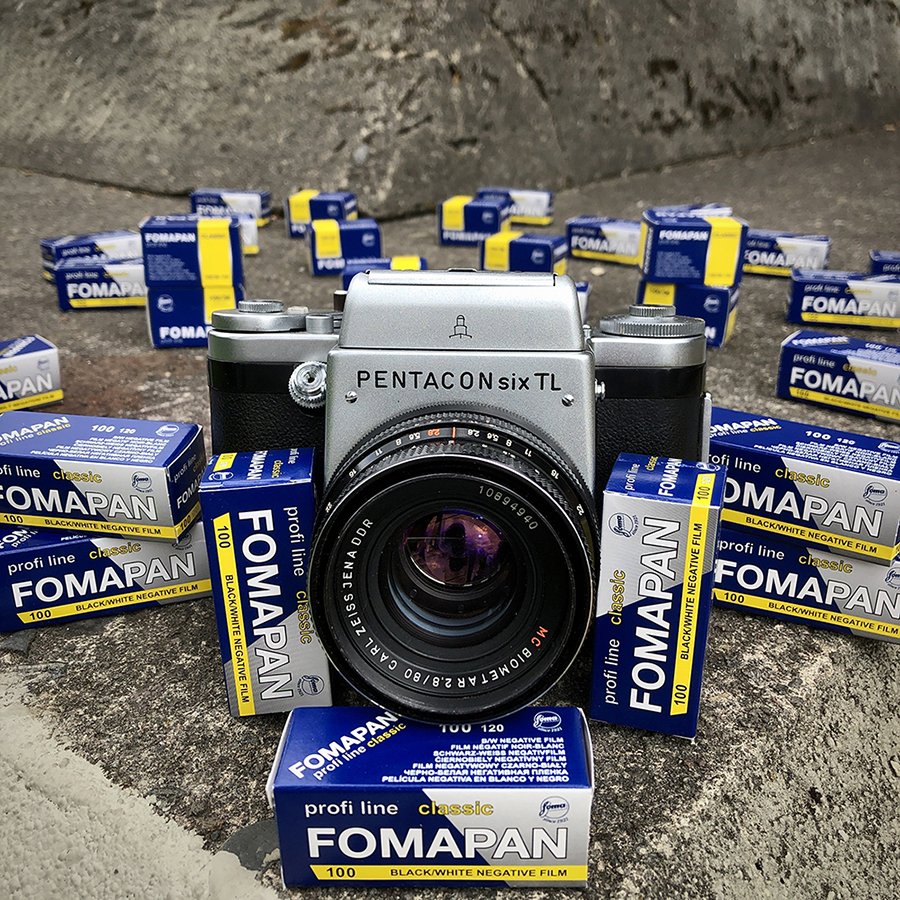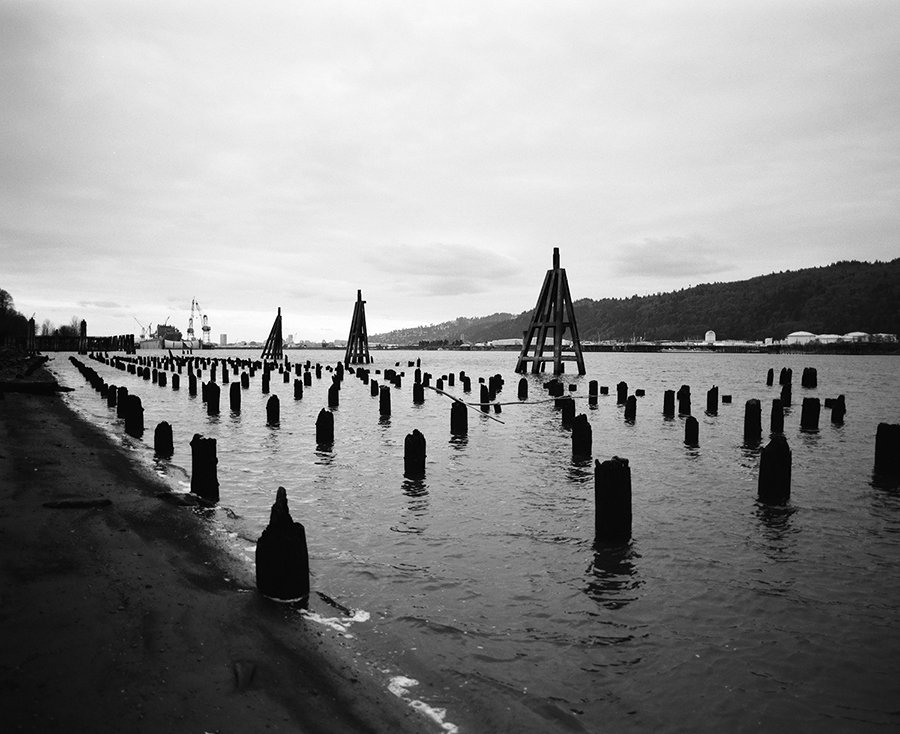Film Friday - June 13th, 2025. Fomapan 100 Film Review
There’s these two cameras in my collection: the Hasselblad 500C and the Pentacon Six TL. You are likely familiar with the Hasselblad already, and you might even know the Pentacon as well. These cameras have much in common. They are both from roughly the same era. They are both medium format 6x6 SLR cameras. They both sport Zeiss lenses - with the Hasselblad having Carl Zeiss and the Pentacon using Zeiss Jena. They are both mechanical. And, I love using both. But they also have some significant differences. The Hasselblad is definitely the superior camera in terms of its design, build, and quality of its lenses. Those Carl Zeiss optics are sharper than their Zeiss Jena counterparts. My Pentacon is also limping along a little bit. It is not as well built and the years have not been as kind to it. So you might wonder, why use the Pentacon at all then? That is because there is more to a camera than the quality of its design, or the sharpness of its lenses. I would tell you that my Hasselblad images are sharp but feel a bit cold and clinical at times, while the Pentacon’s images have much more character and are warmer (not in terms of color cast, but in personality). There is a charm to the Pentacon, a charisma, that the Hasselblad lacks. Where am I going with this? Why a comparison between Hasselblad and Pentacon to kick off a Film Friday review of Fomapan 100? It is because Fomapan 100 is much like my Pentacon Six TL. There are technically superior films out there. Fuji Acros is finer grained and has better reciprocity, Kodak TMax 100 and Ilford Delta 100 have better resolution, Rollei RPX has more tonality. But Fomapan 100 has charm that is all its own. We like to say here at the shop that there is no such thing as a bad film b&w film, that they all simply have different qualities and characteristics to learn. We really enjoy using Fomapan 100 here, but it is a film with its pros and cons. So let’s take a longer look at Fomapan 100 and learn some of those traits.
Fomapan 100 is manufactured by Foma Bohemia in Czech Republic. The company has a long history, having just celebrated their 100th anniversary. Initially Foma Bohemia made photographic plates and papers but later expanded into medical and industrial x-ray films. They are one of very few film manufactures not named Kodak, Fuji or Ilford to have survived the digital revolution of the early 2000s. In fact the Fomapan triumvirate of films was introduced during that time with Fomapan 100 Classic appearing on the scene around 2002. In the two decades since its release the film has remained unchanged - or at least its data sheet has remained unchanged.
Even when photographing new world scenes, Fomapan 100 has an old world feel to it. Image made with a Reality So Subtle 6x6 pinhole.
The defining quality of Fomapan 100 is its “feel”. As we alluded to in our introduction, this film won’t razzle and dazzle you with its resume of accomplishments, but rather lure you in with its rough-around-the-edges charm. This look and feel is the combination of individual bits and pieces. So let’s pull this tapestry apart a bit and give you a run-down of some of its elements.
The best place to start is Fomapan 100’s grain. This is a cubic grain film, in the same vein as other classic film emulsions like Tri-X or HP5 or Rollei RPX. Cubic grain is a bit coarser in its pattern but it is also a look we are very familiar with as the history of photography is full of such films. While coarser, cubic grain films also have a more organic appearance to their grain pattern. Perhaps this is why you can have a toothier image where the grain still feels very natural and is a component of the image rather than a hindrance to it. For those that like really specific measurements, Fomapan 100 has an RMS granularity rating of 13.5. Compare this to the RMS rating of 10 for the old Kodak Plus-X film (ISO 125) or the RMS 9 of Agfa APX 100. In fact, it is very close to being equivalent with the RMS of 14 that Agfa APX 400 rates. So Fomapan 100 is not a fine grained film by any comparative standards other than those set by the other Fomapan films. But as we are wont to do, we’d argue that grain is neither a good or bad characteristic on its own, it all depends on what look you are after and how you use. If you want an image with more texture, more grit to it, with more the look of an old school black and white film photo then Fomapan 100 has no issue giving you just that.
Fomapan 100’s grain will be less noticeable in medium format, but it is still one of the grainiest ISO 100 films out there. Use this to your advantage. Image made with a Holga.
Hand in hand with the film’s grain is often its resolution - or how well it records fine details. Unsurprisingly, Foma’s data sheet for the film claims it has high resolving power. We are more than a bit skeptical of this statement. It seems a sharp enough film but we don’t think it plays in the same ballpark as TMax 100 or Acros. It probably isn’t even in the same city. Our natural inclinations though are to use this film in our Holga and pinhole cameras. It’s quirks seem to fit with the already quirky nature of those cameras, plus resolving power becomes far less relevant when you are using such cameras. Nonetheless, we have put a roll or two through our Hasselblads and been moderately impressed by the results. So in this regard we feel its safe to say that Fomapan 100 is at least middle of the pack.
While we aren’t sure how far we believe Foma’s claims of “high resolving power” the film does seem to be sharp enough at least that you will never think of it as a soft film. Image made with a Hasselblad Flexbody.
Where Fomapan really gets interesting though is its tonality and contrast. Many users of the film point out that Fomapan 100 has a tendency toward deep, “crunchy” shadows. Our own use of the film seems to confirm this. Fomapan’s shadows often fall off quite quickly but at the same time its tonality above middle grey tends to be very rich, even and slow to move to full white. What we mean is that Fomapan tends to hold onto its highlights really well, often rendering them with deeper tonality than we are use to seeing out of black and white films. Film overall tends to be forgiving of overexposure, but if you are running into issues of clipped highlights in your scenes, try a roll of Fomapan 100 as its highlights are usually pretty soft. In this sense it reminds us a bit of Bergger Pancro film.
Opinions vary wildly as to whether Fomapan 100 is versatile or not. Some photographers say it is a pretty unforgiving film, while others claim they can shoot it anywhere between ISO 50-400 without adjusting development at all. Foma’s own datasheet backs this claim up. In terms of our personal experience, we have always rated it at its box speed of ISO 100 and called it good, and to that extent have never had issues with our Fomapan exposures.
Even the brightest spots in this image resist feeling too clipped and have density to them. Fomapan works some weird magic with its upper tonal values. Image made with a Holga.
It is worth adding that reading over the tech sheet for Fomapan 100 shows it has a spectral sensitivity extending well into the deep red end of the visible spectrum, tapering off at about 670nm. While not sensitive enough to make Fomapan 100 an infrared capable film this increased sensitivity at the red end of the spectrum does mean it will have a slight tendency to lighten skin tones. Something to keep in mind if you have some portraiture planned.
We’re going to round out our survey of Fomapan’s qualities by mentioning its reciprocity failure rates. This is something that is usually on our radar because we like our long exposures and ND filters, but even if we didn’t have this tendency Fomapan 100 would probably still have pinged our radar because it has perhaps the most notable failure rate of any film we have ever reviewed. Foma’s data sheet recommends giving the film a full stop of compensation at 1 second. This means that if you meter for a 1 second exposure, you really need to be doing 2 seconds. By the time you reach 10 second exposures the film requires 3 stops of extra light. So that 10 second exposure should really be 80 seconds. The data sheet’s chart stops at 100 seconds, showing a 4 stop correction. And woe to the photographer who wants to expose longer than that. You can look at this two ways. One one hand this is not the film you want to take out at night, or put behind ND filters. On the other hand, if you are struggling to get exposures as long as you want, perhaps because your f-stop doesn’t stop down far enough or your ND filters are too light for the conditions, then maybe Fomapan 100’s exposure falloff might prove handy. As we said above, we shoot a lot of it in pinhole cameras running 2-15 second exposures and we have usually only added the typical 1 stop of extra exposure, and so far so good. So maybe, despite its steep failure rate, there is something to be said about Fomapan’s forgiveness of underexposure.
We are approaching the conclusion of our look at Fomapan 100. And while we feel there is value in analyzing the various facets of this film, we’d remind you of the short story we told in the opening of this review. Sometimes there is more to a film (or a camera for that matter) than its technical capabilities. There is its charm and charisma to take into account, and be wooed by. And thus we’ll conclude by repeating that despite Fomapan 100’s grain, despite its unique tonality, regardless of its cliff-like reciprocity failure, this is a film that has won us over with its personality. And we’d encourage you to give this film an introduction and see if you feel the same way. We won’t be surprised at all if you do.
We have almost every film stock available on the market. Check it out!
If you need an excellent lab for meticulous film developing, topnotch optical prints, traditional darkroom printing and superb film scanning, we’re your lab!
Also, sign up for our weekly newsletter The Loupe and keep your eyes peeled on our social media feeds every Friday when we feature a different film and also offer it at a one day discount of 15% off!
There are few places in the world seemingly better suited for Fomapan 100’s particular character than a foggy Oregon coast. Image made with a Zero Image 6x9.
Image made with a Reality So Subtle 6x6.
One of our first ever shot rolls of Fomapan 100 saw the film taking a day trip up to Seattle. Image made with a Reality So Subtle 6x6 Dual Pinhole, using the upper of the two pinholes.
Yup, you guessed it, yet another pinhole image made with Fomapan 100.
The grit of Fomapan 100 really stands out in 35mm. Image made with a Canon AE-1 Program.
One of Fomapan’s more interesting qualities is how it renders skin tones - lightening them more than most B&W films. Image made with a Hasselblad 500C/M.
We’ve now used Fomapan 100 across a number of cameras from Hasselblad to Pentax 67 to pinhole, and even a Fuji G617 as seen here.
One more 6x17cm panoramic image made with a Fuji G617 and Fomapan 100.






















